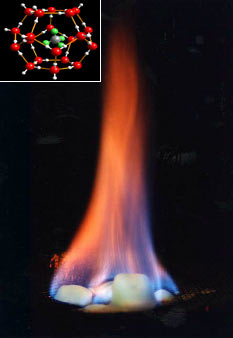Methane clathrate
|
|

Source: USGS
Methane clathrate hydrate is a form of water ice that contains a large amount of methane within its crystal structure. Originally thought to occur only in the outer regions of the solar system where temperatures are low and water ice is common, extremely large deposits of methane clathrates have been found under sediments on the ocean floors of Earth. Methane clathrates are common constituents of the shallow marine geosphere, and they occur both in deep sedimentary structures, and as outcrops on the ocean floor. Methane hydrates are believed to form by migration of gas from depth along geological faults, followed by precipitation, or crystallization, on contact of the rising gas stream with cold sea water.
Methane clathrates remain stable at temperatures up to 18 °C. The average methane clathrate hydrate composition is 1 mole of methane for every 5.75 moles of water, though this is dependent on how many methane molecules "fit" into the various cage structures of the water lattice. The observed density is around 0.9 g/cm3. One liter of methane clathrate solid would therefore contain, on average, 168 liters of methane gas (at STP).
| Contents |
Natural deposits
Gas_hydrates_1996.jpg
Source: USGS
Methane clathrates are restricted to the shallow lithosphere (i.e. <2000m depth). Furthermore, necessary conditions are found only either in polar continental sedimentary rocks where surface temperatures are less than 0°C; or in oceanic sediment at water depths greater than 300m where the bottom water temperature is around 2°C. Continental deposits have been located in Siberia and Alaska in sandstone and siltstone beds at less than 800m depth. Oceanic deposits seem to be widespread in the continental shelf (see Fig.)) and can occur within the sediments at depth or close to the sediment-water interface. They may cap even larger of deposits of methane gas (Kvenvolden, 1995).
Oceanic
There are two distinct types of oceanic deposit. The most common is dominated (>99%) by methane contained in a structure I clathrate and generally found at depth in the sediment. Here, the methane is isotopically light (δ13C < -60‰) which indicates that it is derived from the microbial reduction of CO2. The clathrates in these deep deposits are thought to have formed in-situ from the microbially-produced methane, as the δ13C values of clathrate and surrounding dissolved methane are similar (Kvenvolden, 1995).
These deposits are located within a mid-depth zone around 300-500m thick in the sediments (the Gas Hydrate Stability Zone, or GHSZ) where they coexist with methane dissolved in the pore-waters . Above this zone methane is only present in its dissolved form at concentrations that decrease towards the sediment surface. Below it, methane is gaseous. At Blake Ridge on the Atlantic continental rise, the GHSZ started at 190m depth and continued to 450m, where it reached equilibrium with the gaseous phase. Measurements indicated that methane occupied 0-9% by volume in the GHSZ, and ~12% in the gaseous zone (Dickens, 1997).
In the less common second type found near the sediment surface some samples have a higher proportion of longer-chain hydrocarbons (<99% methane) contained in a structure II clathrate. Methane is isotopically heavier (δ13C is -29 to -57 ‰) and is thought to have migrated upwards from deep sediments where methane was formed by thermal decomposition of organic matter. Examples of this type of deposit have been found in the Gulf of Mexico and the Caspian Sea (Kvenvolden, 1995).
Some deposits have characteristics intermediate between the mirobially- and thermally-sourced types and are considered to be formed from a mixture of the two.
Reservoir size
The size of the oceanic methane clathrate reservoir is poorly known, and estimates of its size have historically decreased as knowledge of its sedimentology has increased. Recent estimates constrained by direct sampling are based on the extent of hydrate deposits (10-30% of the GHSZ) and the average methane concentration within it (0.9-1.5% by volume). These suggest the global inventory lies between 1-5 x 1015 m3, or about 10x the size of the conventional gas reservoir. See Milkov (2004).
Continental
Methane clathrates in continental rocks are trapped in beds of sandstone or silstone at depths of less than 800m. Sampling indicates they are formed from a mix of thermally- and microbially- derived gas from which the heavier hydrocarbons were later selectively removed. These occur in Alaska and Siberia.
Commercial Use
The sedimentary methane hydrate reservoir probably contains 2-10x the currently known reserves of conventional natural gas. This represents a potentially important future source of fossil fuel. However, in the majority of sites deposits are likely to be too dispersed for economic extraction (Milkov, 2004). Others problems facing commercial exploitation are: detection of viable reserves; and development of the technology for extracting methane gas from the hydrate deposits. A research and development project (http://www.mh21japan.gr.jp/english/mh21/02keii.html) in Japan is aiming for commercial-scale extraction by 2016. A potentially economic reserve in the Gulf of Mexico may contain ~1010m3 of gas (Milkov, 2004).
Climate change
Sudden release of methane clathrate has been hypothesized as a cause of past and maybe impending climate changes, because methane is a greenhouse gas. Events possibly linked in this way are the Permian-Triassic extinction event, the Paleocene-Eocene Thermal Maximum.
See also
External links
- Geological Research Activities with U.S. Minerals Management Service - Methane Gas Hydrates (http://geology.usgs.gov/connections/mms/joint_projects/methane.htm|USGS)
- IFM-GEOMAR, Kiel, DE (http://www.ifm-geomar.de/|) Burning ice picture (http://www.ifm-geomar.de/index.php?id=gh-allgemein&L=0|)
- Methane Hydrates (http://www.ornl.gov/info/reporter/no16/methane.htm) - discusses U.S. government funding of methane hydrates research
- A research and development project (http://www.mh21japan.gr.jp/english/mh21/02keii.html) in Japan
References
- Dickens GR, Paull CK, Wallace P (1997) Direct measurement of in situ methane quantities in a large gas-hydrate reservoir NATURE 385 (6615) pp. 426-428
- Kvenvolden, K. (1995) A review of the geochemistry of methane in natural gas hydrate. Organic Geochemistry, 23(11-12) pp. 997-1008, .
- Milkov AV (2004) Global estimates of hydrate-bound gas in marine sediments: how much is really out there? EARTH-SCI REV 66 (3-4) pp. 183-197da:metanhydrat
